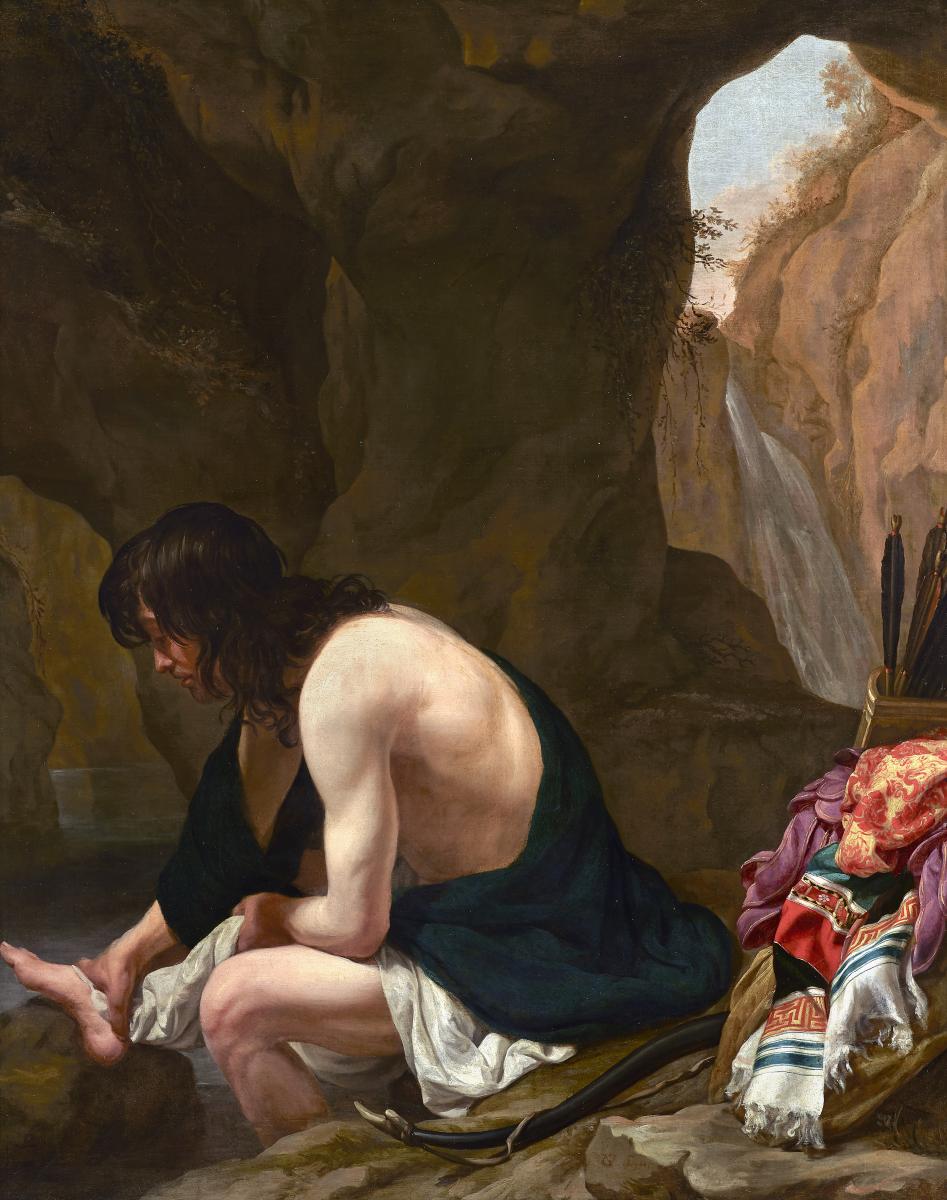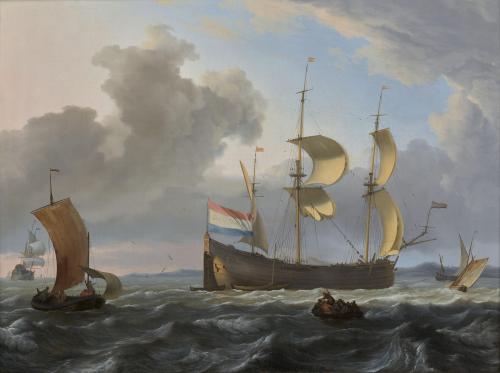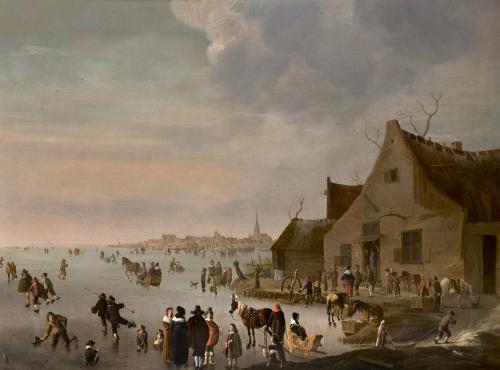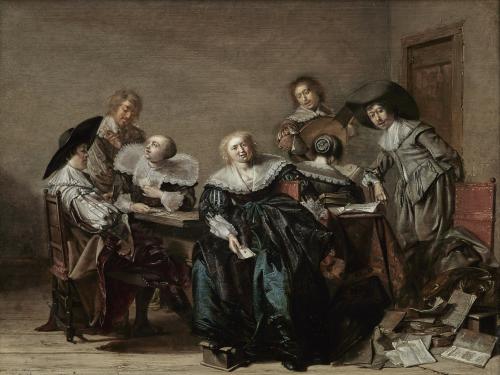

Price on application
This object is eligible for a Certificate of BADA Provenance
The BADA Standard
- Since 1918, BADA has been the leading association for the antiques and fine art trade
- Members are elected for their knowledge, integrity and quality of stock
- Our clients are protected by BADA’s code of conduct
- Our dealers’ membership is reviewed and renewed annually
- Bada.org is a non-profit site: clients deal directly with members and they pay no hidden fees
Gerard Van Kuijl (1604 - Gorinchem - 1673).
Philoctetes on the Island of Lemnos.
Signed with monogram and dated, lower centre: GV[K].F. 1647.
Oil on canvas, 54¼ x 43⅝ ins. (137.7 x 110.8cm).
Provenance:
With Di Castro, Rome.
Acquired by Luisa Vertova Nicolson (widow of Benedict Nicolson), in the 1960s, until 2020.
Literature:
M. R. Waddingham, ‘Another look at Gysbert van der Kuyl’, Paragone, XI, no. 125, 1960, p. 49, fig. 25.
E. J. Sluijter, ‘Niet Gysbert van der Kuyl uit Gouda, maar Gerard van Kuijl uit Gorinchem (1604-1673): een. Identiteitsverwisseling sinds Houbraken’, Oud Holland, XCI, no. 3, 1977, pp. 169, 174-6, 179 and 194, no. A4, fig. 6.
B. Nicolson, Caravaggism in Europe, ed. L. Vertova, Turin, 1990, Vol. I, p. 131; Vol. III, pl. 1371.
J. Davidson Reid, The Oxford Guide to Classical Mythology in the Arts, 1300-1990s, New York and Oxford, 1993, Vol. II, p. 893.
Regarded as one of the last representatives of Dutch Caravaggism, Gerard van Kuijl was born in Gorinchem in 1604. He trained in the studio of Gerrit van Honthorst (1590-1656) in Utrecht around 1625, where he was no doubt inspired, like so many other young painters from that city, to make the long and arduous trip to Rome. He arrived in the Eternal City around 1628-29 and lived there for three years. During this time, he shared a house with several other painters in the Via Margutta, in the heart of the district frequented by Dutch and Flemish artists, and became a member the ‘Schildersbent’ (‘band of painters’), an informal association of Northern painters living in the city. In Rome, he would have studied the work of Caravaggio and become familiar with that of his Italian and Northern followers. Van Kuijl had returned to his hometown by 1632, and apart from the years from 1641 to 1648 when he lived in Utrecht, he seems to have worked for the rest of his life in the relative backwater of Gorinchem. All of his small known body of work was executed after his return to the Netherlands. He painted history subjects, genre scenes and a few portraits. He died in 1673, a victim of the plague.
According to Greek mythology, Philoctetes was the son of Poeas, King of Meliboea, in Thessaly. When Hercules was close to death, he wished to be burned alive on a funeral pyre in order to cut short his agony. However, no-one but the young Philoctetes was willing to light the fire, and in return for this favour, Hercules gave him his bow and his unerring arrows. Some years later Philoctetes joined the Greek expedition to conquer Troy, but on the outward journey he was bitten on the foot by a snake. The bite became infected and Philoctetes was put ashore on the deserted island of Lemnos because his cries of pain disturbed his companions, while the Greek army continued its journey to Troy. For ten years he lived in solitude in a cave, suffering great pain and surviving by hunting wild birds and animals with his bow, while all the time harbouring a deep hatred for the Greek army that had abandoned him. After ten years of war, a prophet predicted that the Trojan War could not be brought to an end without Hercules’s legendary bow and arrows, so Ulysses and Neoptolemus sailed back to Lemnos and persuaded Philoctetes to return with them to Troy. Later, his foot healed, Philoctetes fought in Troy, achieving glory and killing many Trojans.
Van Kuijl’s haunting image of Philoctetes tending his wounded foot is one of the few dated works by this enigmatic master. Painted in 1647, probably in Utrecht, it depicts the Greek hero, long-haired and semi-naked, seated in a cave, with one foot in a stream of water and the other resting on a rock. The young man’s concentration is entirely focused on his injured foot to which he is applying a white cloth. Resting on the ground beside him is the bow of Hercules and close by the quiver of arrows, together with a crumpled leather tunic and a brightly coloured sash. In the upper right-hand corner, a cascade of water gushes into the cave above which a patch of blue sky can be glimpsed. Bright light entering from above falls upon the solitary figure, boldly modelling his pale flesh tones, and the folds in the draperies. Behind, light reflected off the surface of the water illuminates a submerged passageway and a column of twisting rock formations that rises overhead. Besides the flashes of vivid colour in the sash in the right foreground, the palette throughout is cool and restrained.
The choice of subject is a highly unusual one in Dutch seventeenth-century art, apparently without any known pictorial precedents. The ancient Greek playwright Sophocles devoted a tragedy to the story of Philotectes, but Sluijter argues that it was an unlikely source for a Dutch seventeenth-century painter[i]. On the other hand, Philoctetes does feature in Ovid’s Metamorphoses and Virgil’s Aeneid, both popular sources for seventeenth-century painters, but the full story of the wound to his foot is not mentioned in either of them. As identified by Sluijter, the most likely source for van Kuijl’s treatment of this subject was the widely-used commentary by Maurus Servius Honoratus on Virgil’s Aeneid[ii], in which the episode in question is related in detail. The subject however gained popularity in the late-eighteenth- and early-nineteenth-centuries and was adopted by such artists as James Barry[iii], Jean-Germain Drouais[iv], Nicolaj Abilgaard[v] and William Blake[vi]. The image of Philoctetes as an exemplum of the stoical endurance of suffering evidently appealed to the romantic sensibilities of that time.
Van Kuijl’s credentials as a Dutch Caravaggist rests primarily on his musical companies, card-players, and other genre subjects, with half-length figures and dark Caravaggesque lighting, reminiscent of Honthorst and Jan van Bijlert (1597/8-1671). However, this painting, as well as some of his other history paintings, show a classicising restraint that reflects the direction taken by other Dutch Caravaggists, including Honthorst, after their return from Rome to the Netherlands.
Biography
The son of Frank van Kuijll and Johanna van Blockland, Gerard van Kuijl was born in Gorinchem (also known as Gorkum) on 30 January 1604. In his Teutsche Academie (1675) the German painter-biographer Joachim von Sandrart mistakenly called him “Gerard van Krick”, and for centuries he was confused with Gisbert van der Kuijl from Gouda, until correctly identified by Sluitjer in 1977[vii]. It is presumed that van Kuijl was a pupil of Gerrit van Honthorst in Utrecht since his is documented in that city in 1625, when together with his fellow student and townsman Alexander van Wevelinckhoven (1606-1629), he acted as witness to the will of Honthorst’s wife Sophia Coopmans. In 1627, he made a will of his own in Gorinchem, witnessed by van Wevelinckhoven, possibly in preparation for a trip to Italy. The van Wevelinckhoven and van Kuijl familes were closely linked by marriage, and it is likely that the two young men travelled to Rome together, sometime before 1629. Van Kuijl is identified as the ‘Gerardo fiamingo’ or ‘Gherardo pittore’ mentioned in Roman documents, who lived for three years (1629-31) with the French painter Jean Ducamps (c. 1600-1658), known in Italy as Giovannni di Filippo del Campo, in a house on the Via Margutta. In Rome, he joined the Schildersbent, also known as the Bentveughels, or ‘birds of a feather’, an association of Northern artists living in Rome, and took the nickname Stijgbeugel (Stirrup). His friend van Wevelinckhoven, with whom he also shared the house in the Via Margutta, died in Rome in 1629, but van Kuijl remained there until at least July 1631. However, he was back in Gorinchem by 1632, when he joined the Brotherhood of the Romans in Gorinchem (Broederschap der Romeinen binnen Gorinchem), a dining club comprising people who had visited Rome, and got married to Margaretha Dierout. From 1641 to 1648 van Kuijl lived with his family in Utrecht, before returning to his hometown. He remained in Gorinchem until he fell victim to the plague, dying on or shortly before 6 March 1673.
[i] E. J. Sluijter, ‘Niet Gysbert van der Kuyl uit Gouda, maar Gerard van Kuijl uit Gorinchem (1604-1673): een Identiteitsverwisseling sinds Houbraken’, Oud Holland, XCI, no. 3, 1977, p. 176.
[ii] See A. F. Stocker et al. ed., Servianorum in Vergilii Carmina Commentariorum. Editiones Harvardianae, Vol. 3, p. 155- 157.
[iii] Study for Philoctetes on Lemnos by James Barry, 1770, Tate Britain, London.
[iv] Jean-Germain Drouais, Philoctetes on Lemnos, 1778, Musée des Beaux-Arts, Chartres, France.
[v] Nicolai Abilgaard, The wounded Philoctetes, 1775, Statens Museum for Kunst, Copenhagen.
[vi] William Blake, Philoctetes and Neoptolemus at Lemnos, Harvard Art Museums, Cambridge, Massachusetts, U.S.A. .
[vii] E. J. Sluijter, op. cit, pp. 166-194.
Stock number
VP4931The BADA Standard
- Since 1918, BADA has been the leading association for the antiques and fine art trade
- Members are elected for their knowledge, integrity and quality of stock
- Our clients are protected by BADA’s code of conduct
- Our dealers’ membership is reviewed and renewed annually
- Bada.org is a non-profit site: clients deal directly with members and they pay no hidden fees




